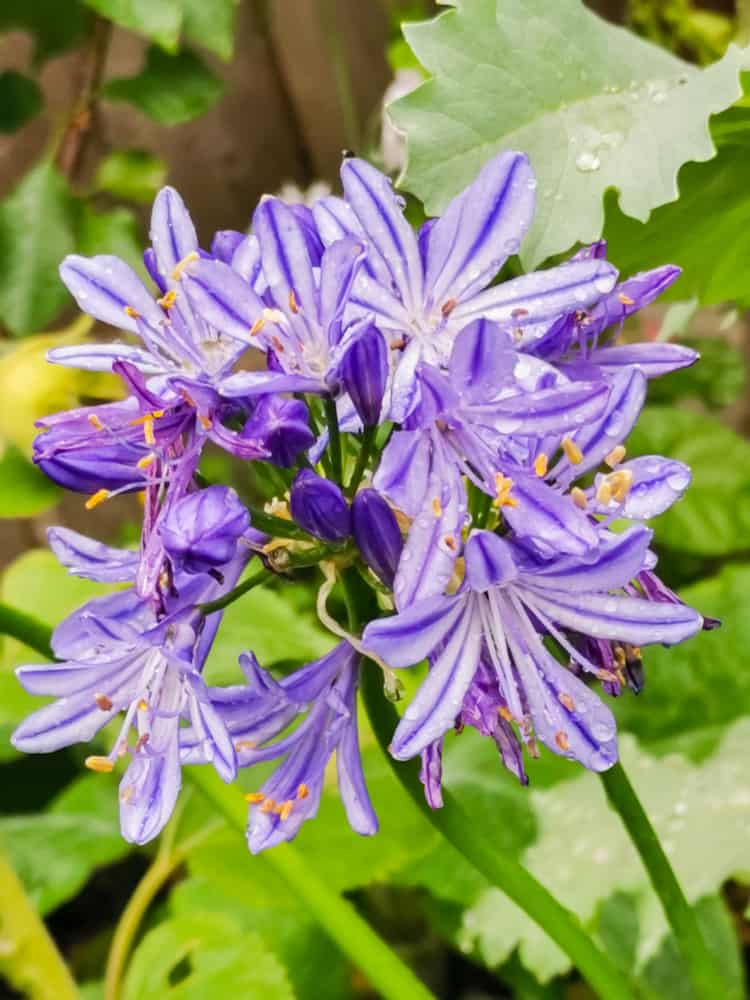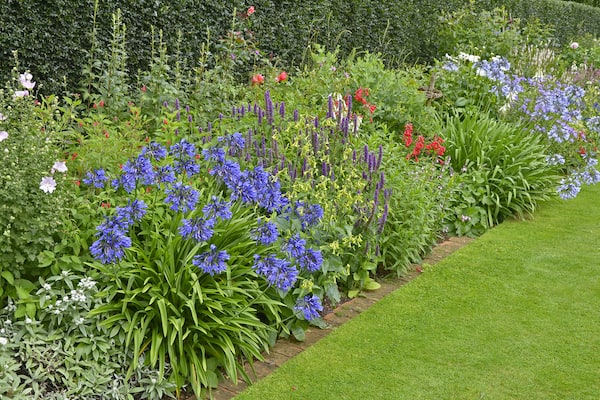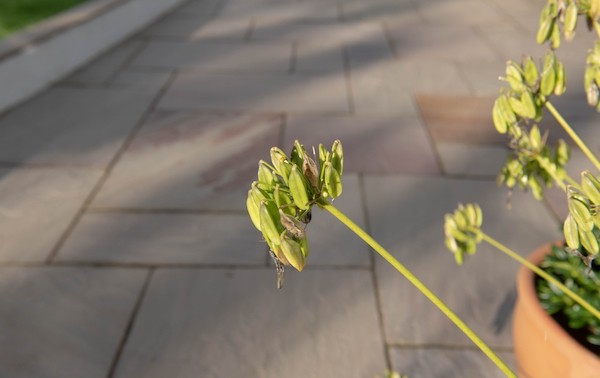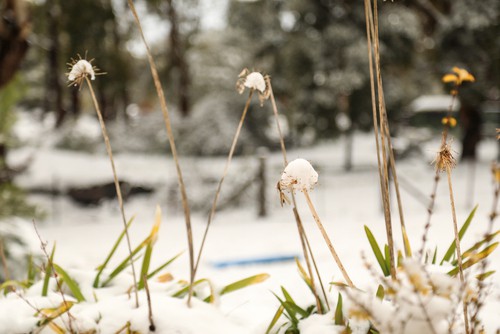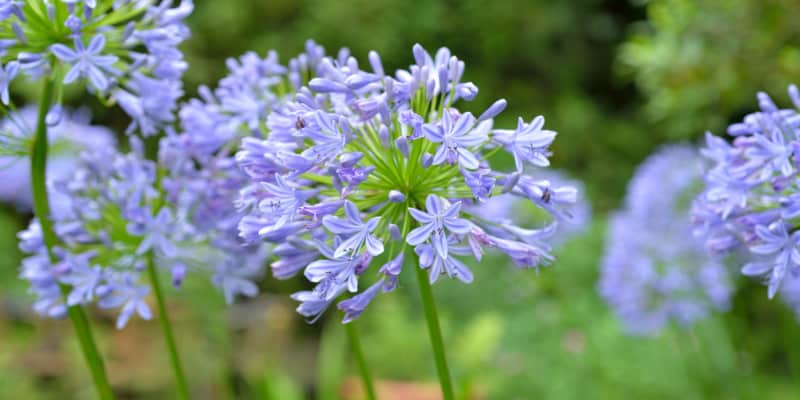
How to grow and care for agapanthus plants (African lily)
Our site is reader supported, this means we may earn a small commission from Amazon and other affiliates when you buy through links on our site.
Agapanthus is also known as the African lily. It’s a sun-loving plant that adds drama to any garden, whether it’s in a border or is the centrepiece of your flower bed. It’s also a great plant for growing on pots, and unlike most plants, they do well when compact.
Read my guide below to learn more about growing agagpanthis but as a general rule, they prefer a sunny sheltered position and well-drained soil.
Types of agapanthus
Agapanthus is a herbaceous perennial. There are two main types of agapanthus – deciduous and evergreen. Deciduous agapanthus is hardier even though they lose their leaves over winter. It’s quite easy to care for this agapanthus which is why they are probably the most popular type. The evergreen types keep their leaves but need special care if they’re to survive over the winter, as they are a little more tender, although still hardy. (See the section Overwintering below for details.) They’ll make superb cut flowers.
Differences also occur in the height of the plant. Most varieties reach 60cm to 1.8m when in full flower with tall flower stalks. You can choose the smaller dwarf varieties for the front of your border and the tallest ones for the back. My personal favorites include some of the dwarf varieties, such as ‘Lilliput’, which reach just 40cm. These are also great for pots and containers. I have a dedicated guide on how to grow agapanthus in contains and pots here
Agapanthus also comes in a range of colours, all of cool hues. Choose from smoky blues, washed-out sapphires, purples and whites. They offer an excellent contrast to other flowers in your garden in the warmer shades of yellow, red, orange and pink.
Grow agapanthus
Where to plant agapanthus
As I’ve mentioned, agapanthus comes in a wide range of heights. The height your chosen variety grows to helps determine where you plant it in your landscape.
But your main choice is whether you plant it directly in your garden beds or in a container, as I often do myself. These plants are well-suited to container life and do surprisingly well in containers.
However, you choose to plant your agapanthus, choose a location that’s in full sun but is sheltered from harsh winds. These plants are also fairly drought-tolerant and can handle being planted in gravel beds. They also don’t mind being by the seaside and thrive in gentle sea winds and salty air making them perfect coastal plants. There are no special instructions to care for agapanthus in these circumstances. Just don’t let them dry out when growing them in containers.
Don’t forget to plant them in full sun
These plants thrive in full sun – and that’s where they flower the most. If they’re in shade, they won’t produce many flowers. However, they can tolerate partial shade for just a few hours of the day and still do very well. In general though, the more sun the better.
Soil
Agapanthus tolerate most soil types as long as one thing is in place – and that’s good drainage. Whatever soil you plant them in, make sure that it’s loose and that it doesn’t hold on to excess water. The best soils are rich and loamy with good drainage. Add grit or compost to clumpy, wet soil to break it up to prevent root rot. And monitor the soil after you’ve watered the plant to make sure that it dries out.
What soil to use for agapanthus grown in pots
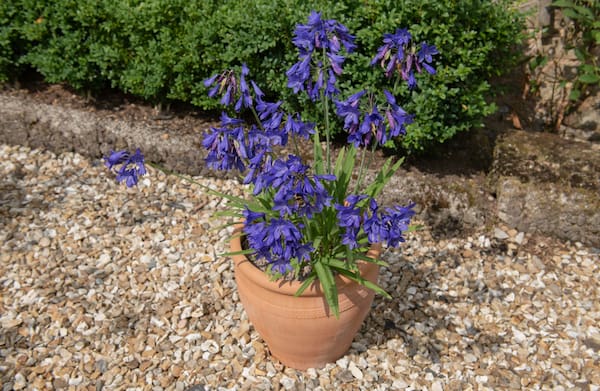
If you’re growing agapanthus in pots, choose a good quality multi-purpose compost to plant it in. I recommend John Innes No. 2 or No.3 compost with some horticultural grit or gravel mixed in for added drainage.
Planting in flower beds
In the ground
Plant agapanthus in spring, from the end of March into April, when the last of what winter has to offer has passed. Dig holes 30cm deep and 30cm apart. The plants actually spread to about 40cm, but they like it when the roots of one overlap those of another (this is why they grow well in pots too). Remember not to plant them anywhere the soil is soggy. This is the one element of the care of agapanthus that’s really key.
Expect blooms in June through to October. And cut the plants back in October and November.
Planting in pots
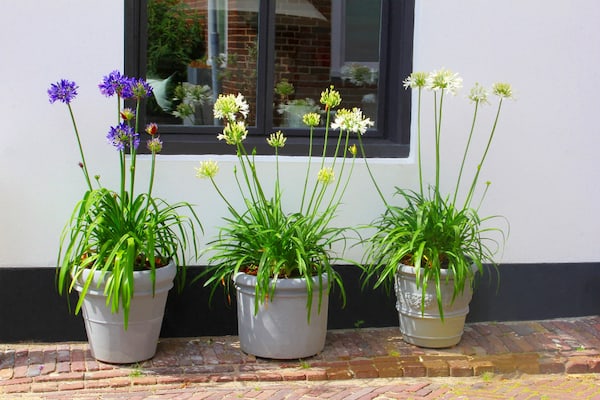
I personally think that agapanthus does better when their roots are squished together in a smaller pot than you would expect. Choose a pot that the plant can grow into but with not much extra room. The rule of thumb is one plant per 30cm pot. I recommend using a Multi-purpose potting mix, so nothing special, and make sure to tamp it down firmly but not make it too compact.
Test that there are enough drainage holes in the bottom of the pot by watering the soil and monitoring the flow of excess water. You need to make sure there a plenty of drainage holes in the bottom of the pot before planting and put some broken crockery in the bottom to ensure the drainage holes don’t come clogged up
Caring for agapanthus plants
Watering agapanthus
In the growing season, water the agapanthus on a regular schedule, especially in their pots. Be especially diligent about doing this in their first year of growth. Once the plants are established, they don’t need much water except in really dry spells.
Make sure the plants are well-watered through to summer, as this encourages the development of new flower buds for blooming the next year.
Feeding agapanthus
Fertilise your agapanthus plants regularly, as they need regular nutrients. For plants in the ground, use a balanced fertiliser in the spring after reading the manufacturer’s instructions. I like to use some Fish, Blood and Bone and rake it into the soil.
For the plants in containers, use a general liquid fertiliser, diluted according to the instructions on the bottle. Use every two weeks from April until the flowers begin to show.
Alternatively, and to be sure you’ve got the right fertiliser, select one that’s specially formulated for agapanthus plants. This has a high potash content to encourage the flowers to bloom. I have also used tomato feed in the past too.
Mulching agapanthus
Mulching has a few advantages, and it’s something I always do: it feeds nutrients to the soil and to the roots of the plants; it keeps moisture in the soil; it keeps the soil cool; and it keeps the weeds down.
Keep a layer of 5cm to 8cm of organic mulch around your plants. Don’t let the mulch touch the stem of the plant or any branches, though, as it encourages bugs and other pests to move in.
In addition, use mulch when you’re overwintering your agapanthus in the ground, as it insulates the roots from any temperature swings and the coldest temperatures, which is what usually kills them off,
What to do with agapanthus after flowering
When the agapanthus flowers have faded, deadhead the plant by snipping off the faded blooms at their base. This encourages the plant to flower longer. You also have the choice of leaving the dead flowers on the plant, so they develop seeds you can use to create new plants, but this takes a long time. However, they also add visual interest to an otherwise stark winter landscape.
You can cut back the plant around October if you want to. This involves removing any stems and yellowed leaves from the deciduous types of an agapanthus. Or you can leave everything in place over winter to provide a warm covering for the soil and the roots.
Overwintering agapanthus
Protect your agapanthus plant over winter from the harsh cold, snow and wind.
For agapanthus grown in pots, place it in a frost-free place that receives daylight, ideally a greenhouse or maybe in your home as a houseplant for the winter. If the plant is in a cool location, wrap the pot in bubble wrap or lagging and wrap the plant in a few layers of horticultural fleece.
If your plant is in the ground in your garden, it also needs winter protection, especially if it’s of the evergreen type. Mulch around the plant and cover it with horticultural fleece if the weather is forecasted very cold.
If you have problems with the leaves on your agapanthus turning yellow or brown, this could be overwatering or an iron deficiency or even pests. You can learn more about yellowing leaves on agapanthus here. You can also learn about when and how to divide agapanthus here.
